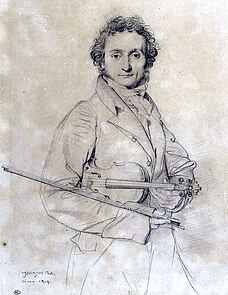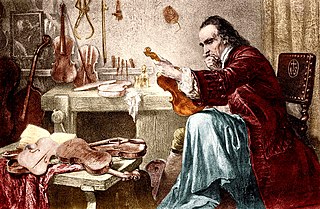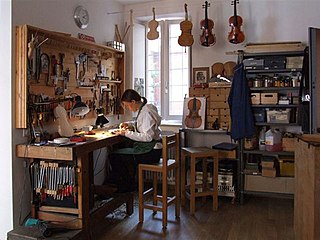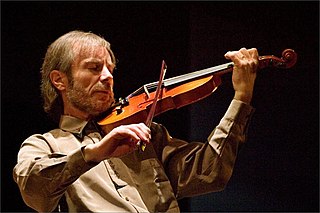Related Research Articles

Isaac Stern was an American violinist.

NiccolòPaganini was an Italian violinist, violist, guitarist, and composer. He was the most celebrated violin virtuoso of his time, and left his mark as one of the pillars of modern violin technique. His 24 Caprices for Solo Violin Op. 1 are among the best known of his compositions, and have served as an inspiration for many prominent composers.

The violin, sometimes known as a fiddle, is a wooden string instrument in the violin family. Most violins have a hollow wooden body. It is the smallest and highest-pitched instrument in the family in regular use. Smaller violin-type instruments exist, including the violino piccolo and the pochette, but these are virtually unused. The violin typically has four strings, usually tuned in perfect fifths with notes G3, D4, A4, E5, and is most commonly played by drawing a bow across its strings. It can also be played by plucking the strings with the fingers (pizzicato) and, in specialized cases, by striking the strings with the wooden side of the bow.

The viola ( vee-OH-lə, alsovy-OH-lə, Italian: [ˈvjɔːla, viˈɔːla]) is a string instrument that is bowed or played with varying techniques. It is slightly larger than a violin and has a lower and deeper sound. Since the 18th century, it has been the middle or alto voice of the violin family, between the violin (which is tuned a perfect fifth above) and the cello (which is tuned an octave below). The strings from low to high are typically tuned to C3, G3, D4, and A4.

A concerto is a musical composition generally composed of three movements, in which either one solo instrument or a group of soloists (concertino) is accompanied by an orchestra or concert band. Its characteristics and definition have changed over time. In the 17th century, sacred works for voices and orchestra were typically called concertos, as reflected by J. S. Bach's usage of the title "concerto" for many of the works that we know as cantatas.

Sonata, in music, literally means a piece played as opposed to a cantata, a piece sung. The term evolved through the history of music, designating a variety of forms until the Classical era, when it took on increasing importance. Sonata is a vague term, with varying meanings depending on the context and time period. By the early 19th century, it came to represent a principle of composing large-scale works. It was applied to most instrumental genres and regarded—alongside the fugue—as one of two fundamental methods of organizing, interpreting and analyzing concert music. Though the musical style of sonatas has changed since the Classical era, most 20th- and 21st-century sonatas still maintain the same structure.

Arcangelo Corelli was an Italian violinist and composer of the Baroque era. His music was key in the development of the modern genres of sonata and concerto, in establishing the preeminence of the violin, and as the first coalescing of modern tonality and functional harmony.

Antonio Stradivari was an Italian luthier and a crafter of string instruments such as violins, cellos, guitars, violas, and harps. The Latinized form of his surname, Stradivarius, as well as the colloquial Strad are terms often used to refer to his instruments. It is estimated that Stradivari produced 1,116 instruments, 960 of which were violins. Around 650 instruments survived, including 450 to 512 violins.

Yehudi Menuhin, Baron Menuhin, was an American-born violinist and conductor who spent most of his performing career in Britain. He is widely considered one of the great violinists of the 20th century. He played the Soil Stradivarius, considered one of the finest violins made by Italian luthier Antonio Stradivari.

A Stradivarius is one of the violins, violas, cellos and other string instruments built by members of the Italian family Stradivari, particularly Antonio Stradivari, during the 17th and 18th centuries. According to their reputation, the quality of their sound has defied attempts to explain or equal it, though this belief is disputed. The fame of Stradivarius instruments is widespread, appearing in numerous works of fiction.

Itzhak Perlman is an Israeli-American violinist, conductor, and music teacher. Over the course of his career Perlman has performed worldwide, and throughout the United States, in venues that have included a State Dinner at the White House honoring Queen Elizabeth II, and at the Presidential Inauguration of President Obama. He has conducted the Detroit Symphony Orchestra and the Westchester Philharmonic. In 2015, he was awarded the Presidential Medal of Freedom. He has been awarded 16 Grammy Awards and a Grammy Lifetime Achievement Award, and four Emmy Awards.

The Red Violin is a 1998 drama film directed by François Girard and starring Samuel L. Jackson, Carlo Cecchi and Sylvia Chang. It spans four centuries and five countries as it tells the story of a mysterious red-coloured violin and its many owners. The instrument, made in Cremona in 1681 with a future forecast by tarot cards, makes its way to Montreal in 1997, where an appraiser identifies it and it goes to auction. The film was an international co-production among companies in Canada, Italy, and the United Kingdom.

Louis Spohr, baptized Ludewig Spohr, later often in the modern German form of the name Ludwig, was a German composer, violinist and conductor. Highly regarded during his lifetime, Spohr composed ten symphonies, ten operas, eighteen violin concerti, four clarinet concerti, four oratorios, and various works for small ensemble, chamber music, and art songs. Spohr invented the violin chinrest and the orchestral rehearsal mark. His output occupies a pivotal position between Classicism and Romanticism, but fell into obscurity following his death, when his music was rarely heard. The late 20th century saw a revival of interest in his oeuvre, especially in Europe.

Friedrich-Max "Fritz" Kreisler was an Austrian-born violinist and composer. One of the most noted violin masters of his day, and regarded as one of the greatest violinists of all time, he was known for his sweet tone and expressive phrasing. Like many great violinists of his generation, he produced a characteristic sound which was immediately recognizable as his own. Although it derived in many respects from the Franco-Belgian school, his style is nonetheless reminiscent of the gemütlich (cozy) lifestyle of pre-war Vienna.

Martín Melitón Pablo de Sarasate y Navascués was a Spanish violin virtuoso and composer of the Romantic period.

Joshua David Bell is an American violinist and conductor. He plays the Gibson Stradivarius.

A luthier builds and repairs string instruments that have a neck and a sound box. The word "luthier" is originally French and comes from the French word for lute. The term was originally used for makers of lutes, but it came to be used already in French for makers of most bowed and plucked stringed instruments such as members of the violin family and guitars. Luthiers however do not make harps or pianos; these require different skills and construction methods because their strings are secured to a frame.

The string section is composed of bowed instruments belonging to the violin family. It normally consists of first and second violins, violas, cellos, and double basses. It is the most numerous group in the typical Classical orchestra. In discussions of the instrumentation of a musical work, the phrase "the strings" or "and strings" is used to indicate a string section as just defined. An orchestra consisting solely of a string section is called a string orchestra. Smaller string sections are sometimes used in jazz, pop and rock music and in the pit orchestras of musical theatre.

Jazz violin is the use of the violin or electric violin to improvise solo lines. Early jazz violinists included Eddie South, who played violin with Jimmy Wade's Dixielanders in Chicago; Stuff Smith; Claude "Fiddler" Williams, who played with Andy Kirk and his Twelve Clouds of Joy. Joe Venuti was best known for his work with guitarist Eddie Lang during the 1920s. Georgie Stoll was a jazz violinist who became an orchestra leader and film music director.

A violin sonata is a musical composition for violin, often accompanied by a keyboard instrument and in earlier periods with a bass instrument doubling the keyboard bass line. The violin sonata developed from a simple baroque form with no fixed format to a standardised and complex classical form. Since the romantic age some composers have pushed the boundaries of both the classical format as well as the use of the instruments.
References
The references in this article are unclear because of a lack of inline citations .(January 2009) (Learn how and when to remove this template message) |
| This United States musical biography article is a stub. You can help Wikipedia by expanding it. |